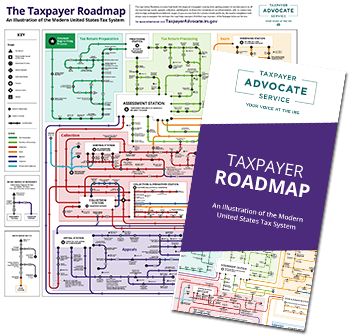
View our interactive tax map to see where you are in the tax process. It could help you navigate your way through the IRS.

A lien release is different from a lien discharge. A discharge removes the lien from a specific property, but taxes are still owed. Whereas a release removes the lien completely because taxes are no longer owed or the IRS’s time to collect has ended.
This notice or letter may include additional topics that have not yet been covered here. Please check back frequently for updates.
The lien is generally released automatically (self-released), or the IRS can file a certificate of release prior to it self-releasing.
The IRS is required to issue a release within 30 calendar days of the date when either:
The type of payment can affect the time when the 30 calendar days begin.
For example, the 30-day period will begin:
When the lien is released, IRS files the certificate of release in public records to alert creditors the balance is no longer due.
The IRS has filed a Notice of Federal Tax Lien (NFTL) for unpaid taxes and the balance has been satisfied or the time the IRS can collect has ended. The tax can be satisfied by full payment, completion of an Offer in Compromise, or the IRS has accepted a bond in exchange for the release.
The time the IRS can collect is generally 10-years and is called the Collection Statute Expiration Date. It can be longer if the IRS is prohibited by law to collect or is permitted by law to add time to the 10-years. When the time the IRS can collect has ended, the IRS can no longer legally collect the tax.
If you need to pay off your taxes, you can:
If you need a copy of a certificate of release and it’s been more than 30-days since the taxes were full paid:
If you are requesting a certificate of release within 30-days of paying off your taxes, the request must be in writing and mailed to the Collection Advisory Group for your area.
View your federal tax records and manage your communication preferences online
Sign in to your Online Account to:



Publication 1,
Your Rights as a Taxpayer
Understanding your notice or letter
Get Help topics
Browse common tax issues and situations at TAS Get Help
If you still need help
The Taxpayer Advocate Service is an independent organization within the IRS that helps taxpayers and protects taxpayers’ rights. We can offer you help if your tax problem is causing a financial difficulty, you’ve tried and been unable to resolve your issue with the IRS, or you believe an IRS system, process, or procedure just isn’t working as it should. If you qualify for our assistance, which is always free, we will do everything possible to help you.
![]()
Visit www.taxpayeradvocate.irs.gov or call 1-877-777-4778.
Low Income Taxpayer Clinics (LITCs) are independent from the IRS and TAS. LITCs represent individuals whose income is below a certain level and who need to resolve tax problems with the IRS. LITCs can represent taxpayers in audits, appeals, and tax collection disputes before the IRS and in court. In addition, LITCs can provide information about taxpayer rights and responsibilities in different languages for individuals who speak English as a second language. Services are offered for free or a small fee. For more information or to find an LITC near you, see the LITC page on the TAS website or Publication 4134, Low Income Taxpayer Clinic List.